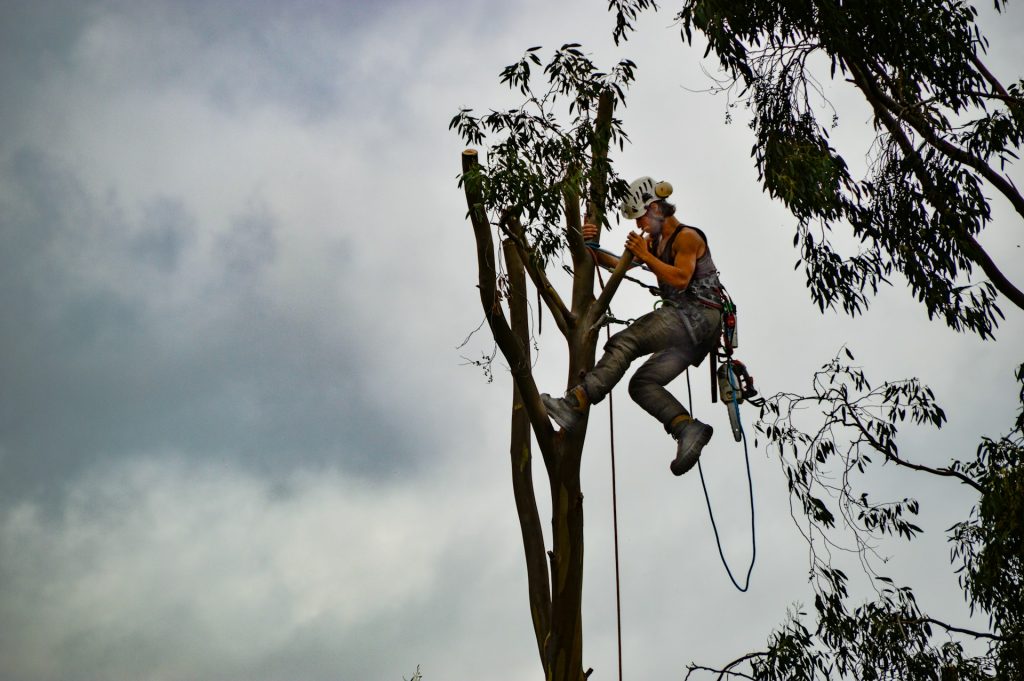How Certified Arborists in Columbus Use Cabling and Bracing to Stabilize Split Tree Trunks Near DrivewaysWhen a tree trunk splits near your driveway in Columbus, it’s a significant safety and property risk. Certified arborists use cabling and bracing to stabilize such trees. Cabling involves installing high-strength steel cables to limit branch movement, often in the upper canopy, particularly for codominant branches or heavy limbs. Bracing provides rigid support using threaded steel rods to hold weak or split sections together, preventing further cracking or splitting. Arborists perform thorough assessments, select appropriate materials, and develop detailed plans to guarantee the stability and longevity of the tree. Regular inspections and maintenance are vital to maintain the effectiveness of these support systems, and by continuing, you’ll learn more about how these techniques can protect your property and secure long-term tree health.  How Certified Arborists in Columbus Use Cabling and Bracing to Stabilize Split Tree Trunks Near DrivewaysWhen dealing with split tree trunks near your driveway in Columbus, OH, certified arborists often turn to cabling and bracing as a safer and more effective solution than removal. These techniques involve installing high-strength cables or steel rods to support and stabilize the tree, reducing the risk of branch failure and structural collapse. By engaging a certified arborist, you can guarantee that your tree is properly assessed and supported, mitigating potential hazards and extending the tree’s lifespan. The Dangers of Split Tree Trunks Near Residential DrivewaysSplit tree trunks near your driveway can pose significant risks to your property and personal safety, as they can suddenly fail and cause damage or injuries. If a tree trunk splits and falls, it could hit your vehicle, damage your home, or injure someone, leading to costly repairs and potential liability issues. Certified arborists in Columbus use cabling and bracing to stabilize these trees, preventing such hazards and ensuring the tree remains safe and healthy. How trunk failures pose property damage and liability risks in urban settingsTrunk failures in urban trees can pose significant risks to both property and personal safety. If a split tree trunk collapses, it can damage homes, driveways, and other structures, leading to costly repairs and potential liability. A certified arborist can conduct a tree risk assessment to identify split tree trunks and recommend cabling or bracing to mitigate this liability risk and protect your property. What is Tree Cabling and Bracing and When Is It Used?Tree cabling and bracing are techniques used by certified arborists to support and stabilize trees with structural weaknesses, such as split trunks or weak limbs. Cabling involves installing high-strength steel cables in the tree’s canopy to limit branch movement and redistribute weight, while bracing uses steel rods to provide rigid support to weak branches or split crotches. When your tree shows signs of structural issues, such as V-shaped trunks, cracked limbs, or visible cracks, cabling and bracing can be essential to prevent failures and guarantee the tree’s safety and longevity. A breakdown of the hardware, techniques, and use cases for structural supportWhen dealing with structurally vulnerable trees, especially those with split trunks near driveways, certified arborists in Columbus often turn to cabling and bracing as effective solutions. For tree cabling, they use high-strength steel cables installed in the upper canopy to redistribute weight and reduce branch movement. Bracing involves threaded steel rods inserted through the trunk or branches to stabilize splits and cracks, preventing further damage. This combination of techniques, often combined with pruning, provides extensive support and guarantees the tree’s stability, making it a key part of preventive tree care in Columbus, OH. How Certified Arborists Perform Tree Stabilization in ColumbusWhen you need to stabilize a split tree trunk near your driveway in Columbus, certified arborists follow a precise process. First, they conduct a thorough assessment to identify the structural weaknesses and determine whether cabling or bracing is necessary. They then select and install high-quality equipment, such as flexible steel strand cables or threaded rod braces, according to industry standards and best practices, ensuring the tree receives the right support to prevent further damage or failure. Assessment, equipment standards, and installation workflow explainedTo guarantee the safety and stability of a tree with a split trunk near a driveway, certified arborists in Columbus, OH, begin with a thorough assessment. They evaluate the tree’s structure, weaknesses, and points of stress to decide between tree preservation and removal. Following ANSI A300 standards, they use cabling and bracing to redistribute weight and stabilize the tree, a vital practice in urban tree management. The arborist develops a cabling plan, selects appropriate hardware, and installs cables and braces strategically to support weak areas, ensuring the tree’s longevity and safety. Regular inspections are essential to maintain the system’s effectiveness. Preventive Maintenance and Long-Term Tree HealthTo guarantee your trees remain stable and safe, regular follow-up care and monitoring are essential after cabling and bracing. You should have a certified arborist inspect the cabling and bracing hardware periodically, typically during annual inspections, to check for any signs of wear or needed adjustments. This proactive maintenance helps prevent potential failures and extends the life of your tree, keeping it a valuable and safe part of your property. How follow-up care and monitoring keep your trees stable and safeAfter installing cabling and bracing systems, regular follow-up care and monitoring are essential to confirm your trees remain stable and safe. Certified arborists in urban tree management recommend annual inspections to confirm the support systems are intact and functioning correctly. They check for loose cables, hardware wear, and new structural weaknesses, making adjustments as needed to maintain the tree’s health and stability. |
|
